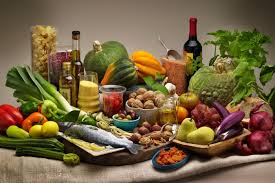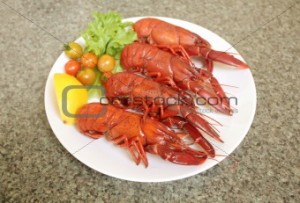 Cuisine. As it is in the Philippines, so it is in Australia: difficult to define. And like the Philippines, it comes in two parts: Before and After Colonization.
Cuisine. As it is in the Philippines, so it is in Australia: difficult to define. And like the Philippines, it comes in two parts: Before and After Colonization.
In the beginning there was a vast southern continent on which dwelt a nomadic race of hunter-gatherers who saw themselves as guardians of the land. For thousands of years they lived, undisturbed, on this immense island, with a deep awareness and understanding of their country and its produce.
To understand the array of produce available to Aboriginal Australians, it is necessary to understand just how big a country it is. The north of Australia is tropical rainforest, its northern-most tip far closer to the equator than Manila or even Mindanao. Hobart, the southern-most city at the foot of Tasmania, dips its toes in Antarctic seas. In the south east there are many miles of alpine mountains. Sydney’s climate is sub-tropical, Adelaide and Perth are temperate and dry, hemmed in by desert and ocean, hot in summer, cold in winter and often suffering from droughts. As travel writer Bill Bryson notes, it’s the largest island in the world, the only island that is a continent and the only continent that is a country.
Europeans arrived on the eastern Australian coast in 1788. Appearing on the  horizon in tall ships with white sails and sporting translucent pallid white skins, they were barely noticed by the aboriginals who thought they were ghosts, but their impact on these gentle natives would be disastrous.
horizon in tall ships with white sails and sporting translucent pallid white skins, they were barely noticed by the aboriginals who thought they were ghosts, but their impact on these gentle natives would be disastrous.
Those early European settlers initially struggled to survive in Australia, a continent they saw as harsh and unforgiving, and a long way from home, full of unfamiliar flora and fauna they were wary of eating. Early efforts at agriculture failed dismally, so settlers had to rely largely on the infrequent visits of ships from England. Even when the ships arrived, freshness and variety had been sacrificed to longevity, and supplies consisted largely of dried and preserved foods. Rationing soon became a heavy burden.
A few brave souls experimented with cooking native fauna, but the majority turned  up their noses at indigenous offerings as soon as familiar crops and animals could be effectively transplanted. Like all migrants the world over, they preferred to stick to familiar food from home, holding on to tradition more tenaciously than those left behind.
up their noses at indigenous offerings as soon as familiar crops and animals could be effectively transplanted. Like all migrants the world over, they preferred to stick to familiar food from home, holding on to tradition more tenaciously than those left behind.
Rations of flour and meat, sugar, tea, salt and rum continued to be the staple diet of the working classes and convicts for over a century. Australia was a ‘country pioneered on corn beef and damper’ as playwright Louis Esson described us in 1918, which led to a nation of devout meat eaters. Eventually, British horticulturalists provided seeds for cabbage and cauliflower, rhubarb and lettuce, onions, turnips, peas and beans, oranges and lemons, domesticating the Australian countryside with a thousand-and-one introduced species, ensuring a diet of thoroughly British fare that would be the staple of settlers for the first two centuries of European habitation.
Yet, like the Philippines, Australia is a nation of migrants. Although it began with a stolid British foundation, Australian kitchens would be influenced by German settlers in South Australia, South American produce introduced by the Spanish Galleon Trade, Irish escapees from the potato famine and Chinese gold miners. Post World War II, all things gastronomic began to change for the better. New  waves of immigration from a decimated Europe brought a smorgasbord of Greeks, Italians, Lebanese and Yugoslavs. The Mediterranean diet made sense in this hot southern land, and Anglo-Australians began to show an increasing interest in the culinary offerings of the ‘new Australians’ who were opening corner shops and delicatessens full of strange, exotic foods.
waves of immigration from a decimated Europe brought a smorgasbord of Greeks, Italians, Lebanese and Yugoslavs. The Mediterranean diet made sense in this hot southern land, and Anglo-Australians began to show an increasing interest in the culinary offerings of the ‘new Australians’ who were opening corner shops and delicatessens full of strange, exotic foods.
Since the 1970s, greater Asian immigration has seen Australian chefs incorporating spices, coconut milk, ginger and lemongrass from India, China, Japan and Southeast Asia into their dishes. More recently, African immigrants have introduced a new edge to local cuisine. Drinking tastes, too, have changed. No longer primarily a county of tea and beer drinkers, we have grown into a nation of wine connoisseurs and coffee addicts.
This free-spirited urge to experiment is shared by chefs and housewives, farmers, grocers and gardeners, a trait described as ‘a defining feature of Australian food culture.’
Once we indulged in an undiluted British diet of baked meat, barbecues and stodgy, nursery puddings quite inappropriate to the climate. Today pizza and pasta, sweet and sour pork, Phad Thai and green chicken curry, fried rice, Mussuman Beef and moussaka have crept into the vernacular, albeit initially indigenized to Anglo-Australian tastes. Yet perhaps the biggest influence these new Australians had was to spread the idea of fresh, good quality ingredients. Fresh  seafood, a staple of most Mediterranean diets, had been largely neglected by northern Europeans in favour of imported smoked and dried fish from Europe, despite a land girt by sea full of delicious seafood.
seafood, a staple of most Mediterranean diets, had been largely neglected by northern Europeans in favour of imported smoked and dried fish from Europe, despite a land girt by sea full of delicious seafood.
I still remember a time when squid or octopus was used as bait, and fish was only served in batter with a huge pile of oil-soaked chips wrapped in newspaper. ‘Throw another prawn on the Barbie’ was, I think, an 80s development. Until then, snags (sausages) and chops ruled the roost at the backyard barbie, usually charcoaled to within an inch of disintegration. Now fresh seafood dominates, where the majority of the population live along the coast.
Many still insinuate that our hotch-potch cuisine, created from scratch, is no cuisine at all. Yet even long established cuisines have continued to adapt under the influence of migrants and traders.
Over the past generation, Australians have started to shrug off a long-standing cultural cringe, and developed pride in our emerging nation. This has led to much popular and academic analysis of what makes us who we are: race, culture, language, sport and food. There has been, in the past twenty five years, a cultural and culinary awakening. Australians faced with a broad range of cuisines from around the globe, have felt no obligation to maintain past traditions, but have – according to food historian Barbara Santich – become ‘ingenious, innovative and adept at making do’.
These days, too, creative Australian chefs are finding inspiration in their own back yard, retrospectively turning to indigenous flora and fauna in order to introduce a true-blue Aussie flavour to our hybrid cuisine.
As we evolve, many still query the possibility of a definable Australian cuisine. Santich believes, instead, that there is a style of cooking and eating that is distinctively Australian. Adapted to the climate, dependent on top quality ingredients, and incorporating a deep attachment to eating outdoors, picnics and barbecues are as much a part of Australian food culture as pasta and parmesan to the Italians. And so many international dishes have become naturalized – indigenized – or simply accepted as part of our daily diets. Taking the best from a bowl full of national cuisines, there has long been a trend towards low-salt, low-fat, healthy cooking that is known, loosely, as Modern Australian.
Santich believes, instead, that there is a style of cooking and eating that is distinctively Australian. Adapted to the climate, dependent on top quality ingredients, and incorporating a deep attachment to eating outdoors, picnics and barbecues are as much a part of Australian food culture as pasta and parmesan to the Italians. And so many international dishes have become naturalized – indigenized – or simply accepted as part of our daily diets. Taking the best from a bowl full of national cuisines, there has long been a trend towards low-salt, low-fat, healthy cooking that is known, loosely, as Modern Australian.
Australians, unlike the Filipinos, do not have a cuisine all their own. Its roots are not Australian but come from half way round the world and half a dozen European countries. But the words of Doreen Fernandez on indigenization is as relevant to Australia as it has been to the Filipinos. Over generations, culinary traditions, like its people, have been stirred, sifted, beaten and blended into the general cooking pot, adapting and absorbing an acceptance of each other’s characteristics and cultures to suit Australian tastes: a young, imaginative and inquisitive nation of transplanted cultures bonding on foreign soil, to form a hybrid cuisine that is still evolving.
 Carlos Celdran, in his tour of Intramuros, uses the metaphor of halo halo to describe the Filipino ‘mix mix’ of races. This could also describe Australians and Australian cuisine, and illustrates how any cuisine, like any nation, is a living organism, an endless exchange of cooking methods and ingredients, ideas and imagination, that is definitively not set in aspic.
Carlos Celdran, in his tour of Intramuros, uses the metaphor of halo halo to describe the Filipino ‘mix mix’ of races. This could also describe Australians and Australian cuisine, and illustrates how any cuisine, like any nation, is a living organism, an endless exchange of cooking methods and ingredients, ideas and imagination, that is definitively not set in aspic.
While those early settlers clung tenaciously to what they knew, recent generations have evolved into a nation of culinary explorers. Television cooking shows have become a phenomenon in Australia: The Cook and the Chef, My Kitchen Rules, Dining Down Under, Everyday Gourmet, River Cottage, to name just a few, and iconic restaurant and TV chefs have led the way in the last 25 years, to a Modern Australian Cuisine that, like Filipino cuisine, is a creative coalescence of cultures. And, like Filipino cuisine, our cuisine also tells a story.
*Adapted from a talk delivered to students at Enderun Colleges, Manila in 2012. With thanks to Google images for the photographs.
